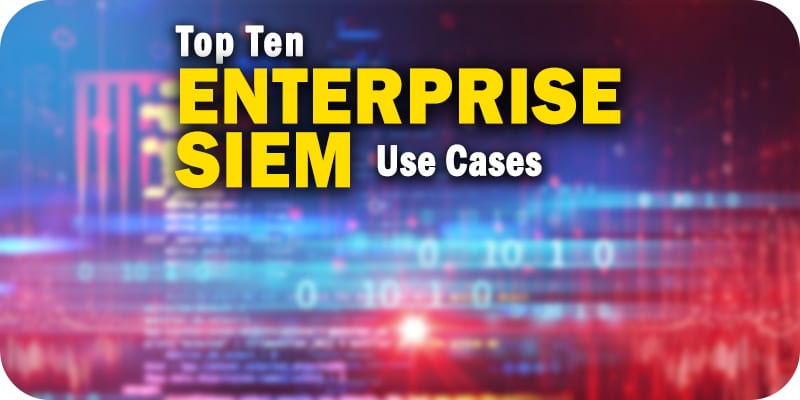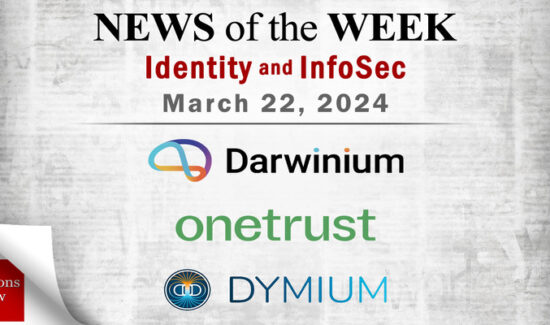The Top 10 Enterprise SIEM Use Cases

What are the top ten SIEM use cases? Why should your enterprise invest in this critical detection-based cybersecurity solution?
SIEM, which combines SIM and SEM technologies, allows enterprises to enjoy threat detection and log management essential to cybersecurity. Additionally, it grants much-needed visibility into on-premises and cloud-based IT infrastructures; SIEM can capture and leverage data whether structured or unstructured. In fact, we can, and have, elucidated on the benefits of SIEM many times before.
Widget not in any sidebars
However, we haven’t yet illustrated the enterprise SIEM use cases which can help your enterprise specifically. Thus we present the top ten enterprise SIEM use cases.
The Top 10 Enterprise SIEM Use Cases
1.Threat Detection and Hunting
One of the most critical SIEM use cases involves digital threat detection. Indeed, SIEM works to correlate security events through your network to identify potential incidents. These incidents include threats as diverse as endpoint threats, insider threats, and phishing attacks.
To help with threat detection, SIEM provides machine learning and analytical capabilities to uncover anomalous behaviors in the network. Also, with SIEM-empowered artificial intelligence, your IT security team can investigate the threats’ root causes and actions.
However, threat detection works reactively rather than proactively. For proactive defense, SIEM can also supplement your IT security team’s threat hunting. This enables your team to discover and mitigate previously unknown network threats before they become full-fledged incidents.
Next-generation SIEM facilitates threat hunting through actionable alerts with context. Additionally, you can benefit from SIEM’s ability to identify environmental anomalies and new vulnerabilities.
2. Single-Pane Visibility
Many SIEM use cases focus on providing increased visibility within enterprise networks, and for good reason. New blindspots continually appear in enterprise networks, especially as the network scales from on-premises to cloud or hybrid environments. Also, as new devices connect to the environment, they create new potential cybersecurity problems. Of course, IT security teams must then try to centralize their monitoring and management for a disparate environment.
Here, SIEM helps by centralizing your monitoring and management into a single pane of glass. This can help you organize your security event data into a centralized platform and thus detect anomalies more easily.
3. Simplified Deployment
Two of the most important SIEM use cases refer to specifically next-generation solutions; in fact, these SIEM use cases exist to help enterprises replace their outdated legacy solutions. One of them refers to the simplified deployment of modern SIEM solutions.
With the continued cybersecurity skills shortage, the importance of simplified SIEM deployment becomes increasingly critical. You need a solution that can fit with the cybersecurity team you have and the data sources of your network. Specifically, you need also consider a solution that can deploy and scale with your data sources, as well as integrate with your current technologies.
4. Reduced False Positives
The other of the next-generation SIEM use cases involve reducing the false positives enterprises receive as security alerts. Generally, SIEM solutions provide your IT security team with security alerts; however, legacy solutions can often run afoul of human complexity and may not distinguish between security events and regular activity.
The end result is your IT security team becoming buried under false positives and security alerts; it makes actually difficult to perform their threat hunting and detection. Thankfully, next-generation SIEM solutions actually work to reduce false positives through advanced threat feeds and geolocation data. Also, next-generation solutions can apply standardization and log configuration can help reduce false positives.
5. Automation
While not an explicit SIEM use case, your enterprise needs an effective and practiced incident response plan. This plan helps employees recognize security incidents, follow clear channels of communication during it, and remediate the threats more effectively. With them, you can seriously mitigate security incidents and limit the financial and reputational damage.
Where do SIEM use cases apply here? SIEM can automate detection and even some remediation. This frees your IT security team to practice, refine, and conduct (as necessary) your incident response. In fact, SIEM’s automation allows your IT security team to perform far more activities and security tasks than before.
6. Contextualization
Let’s imagine this scenario: your SIEM solution picks up a potential Microsoft Word compromise on a major endpoint. Obviously, your IT security team panics and begins an investigation…only to discover that endpoint doesn’t have Microsoft Word. Without context, your IT security wastes time and energy on this false positive.
Thankfully one of the major SIEM use cases involves contextualization; in particular, next-generation solutions can collate internal network data and provide external context. With these technologies, you can stay abreast of emerging threats and recognize factors that may indicate a false positive.
7. Log Collection and Management
Of course, no list of SIEM use cases would be complete without mentioning log collection and log management. Every database, application, user, and server generates huge amounts of log data. SIEM works to centralize the collection of these logs and also to normalize them; this enables easier analysis and security correlation. Also, SIEM allows your IT security team to search through the log for relevant keywords.
Other important components to this SIEM use cases include increased visibility throughout the network and secure log storage.
8. Compliance
SIEM provides comprehensive auditing and reporting; often, they provide out-of-the-box reports for governmental and industrial compliance mandates. Through log collection, your solution can collect the logs in a manner with specific compliance requirements and audit them in a suitable format.
Additionally, many SIEM solutions can automatically generate compliance reports and detect unauthorized network connections.
9. Preventing Insider Threats
One of the major use cases for SIEM involves insider threats. Whether malicious or compromised by external threat actors, SIEM can enact behavioral analysis. This allows the detection of anomalous behavior by users and unwarranted privilege escalation. Moreover, these cybersecurity solutions can correlate network traffic with threat intelligence and analyze possibly connected security events; for example, the presence of rapid encryption programs could indicate the presence of ransomware.
10. IoT Security
One of the most perilous issues facing enterprises today involves IoT devices. While a huge benefit to workflows, IoT devices rarely receive any kind of built-in security. They may suffer from serious vulnerabilities.
So SIEM works to identify unusual traffic patterns connecting to IoT devices and to manage IT vulnerabilities. Additionally, SIEM solutions can detect unpatched or outdated systems.
How to Learn More About SIEM Use Cases
Check out our SIEM Buyer’s Guide and Vendor Map for more on the key capabilities and top providers in the market.























